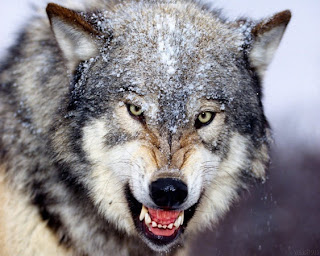How do we get from this?
to this?
The main evolution hypothesis is the "adoption" hypothesis. Obviously no one would try and take in an adult wolf and tame them. So people would capture baby wolves and raise them in their homes as a pet. Or at least they would try and turn them into a pet. For the most part, most of the wolves still would grow up into an untamed adult or they would simply run away from the home before adulthood. This helps show that there was more to the domestication of wolves than just bringing them into a human's house. There had to be a change in the wolves personality and behavior to allow this domestication to occur.
There is a place called the Maya-Wolf Park that has turned raising tamed wolves into a science of sorts to try and help understand the domestication process that occurred thousands of years ago. They take wolf pups from their mothers at an early age and they expose them to human contact for 24 hours a day and 7 days a week. The idea is to socialize the puppies to humans as much as physically possible. The humans who are interacting with the puppies have to be very careful though because it is very easy to reinforce wrong behaviors before you realize you have done it. Socializing the puppies to humans help make the wolves less threatened by human sounds and smells. They want the puppies to trust and befriend the humans, not be afraid of them.
Just simply interacting with the wolf pups is not enough. The next step at Maya-Wolf Park is to only allow the tamest wolves to breed and to breed the tamest together to pass on those genes (whatever genes they may be) that produce a tamer animal. If you repeat this process over and over generation after generation, you end up with a wolf that is truly fundamentally different. You end up with a wolf who really has tameness in its genes.
The problem that some people have with this "adoption" hypothesis is that they don't see what is in this set up for the wolf. Why would the wolf want to go live with humans and be domesticated in the first place? And the answer sounds very familiar to the Russian feral dog article I read. The wolf that is tamer or less afraid of people, and the ones that can interact best with the humans, is the wolf that is most likely to get food from the people. Having a steady source of food and nutrition is a huge advantage for wolves and will allow them to survive to reproductive age better (to pass on their tame genes) than those wolves who have to fend for themselves all the time.
This concept does not explain all the physical differences between wolves and all the variations of dogs we have today (coat colors and sizes and textures) but it does help explain some of the first physical variations between wolves and the wolves that evolved into dogs. Dogs, compared to their untamed wolf ancestors, have smaller teeth and a smaller brain. Having smaller teeth will make humans less afraid of you because its one thing if the wolf doesn't run away when it sees humans but that doesn't help if the human is the one that runs away first. Also, if the wolf doesn't have to chase down and bite its prey to death, it doesn't need as big of teeth to sink into food. by looking at other animals, it is understood that animals who are scavengers instead of hunters don't need as big of brains.


No comments:
Post a Comment